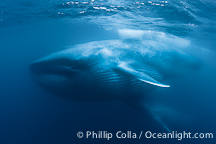Diet Krill
Blue Whale Photos by Oceanlight.com The main food option for Balaenoptera musculus is euphausiids, commonly known as krill. They are crustaceans found throughout the ocean but are most numerous in colder oceanic waters near Antarctica and Iceland. Blue whales have adapted feeding structures to capture them and a multi-chambered stomach capable of breaking the crustacean down. Blue whales stay in cooler waters close to the poles to engulf massive amounts of krill. Krill feed on diatoms and algae, acting as a primary consumer in the oceanic food chain. Other crustaceansRarely do blue whales eat anything besides krill, but when they do the food is usually crustacean species, including copepods and amphipods. Pelagic red crabs, Pleurocodes planipes, are also on the menu blue whales. Acquisition Baleen
Photo courtesy of jdlasica Instead of teeth, blue whales have a baleen. Krill are captured as the whale opens its mouth. Then, the whale pushes against its upper jaw with its tongue and filters out the water through the baleen. Baleen is made up of a protein called keratin, the same protein that our hair and fingernails are comprised of. It is found in all Mysticeti species. Throat Pleats
Blue whale photos by Oceanlight.com To increase the volume of krill in its mouth, blue whales have adapted throat pleats. These folds of skin in the throat can expand into a large pouch that holds large volumes of water. Over a hundred people can fit in the mouth of a blue whale. Once the pouch is filled, it takes about a minute for the whale filter the water in the baleen and empty the pouch. Blue whales use their tongues to push water from through their baleen on the upper jaw. Did you think elephants were large? The tongue of a blue whale weighs as much as an elephant. Digestion StomachThe stomach of Balaenoptera musculus has three chambers: the forestomach; the main stomach; a connecting channel; and the pyloric stomach, which has two compartments. The forestomach, which lacks secretory glands, stores food. Substances stored in the forestomach are broken down by contractions of massive muscular walls and anaerobic bacteria. The fermentation of bacteria in the forestomach parallels that of bacteria in the rumen of a ruminant species. The main stomach has pepsin and hydrochloric acid glands to break down food. The forestomach and the main stomach can hold up to 1000 kg of food. The pyloric stomach has digestive glands. All of these together help break down the chitinous exoskeleton from krill. Having multiple stomach chambers also supports the claim that whales evolved from ruminants. Want to know how they have sex? Proceed to Reproduction. | 
